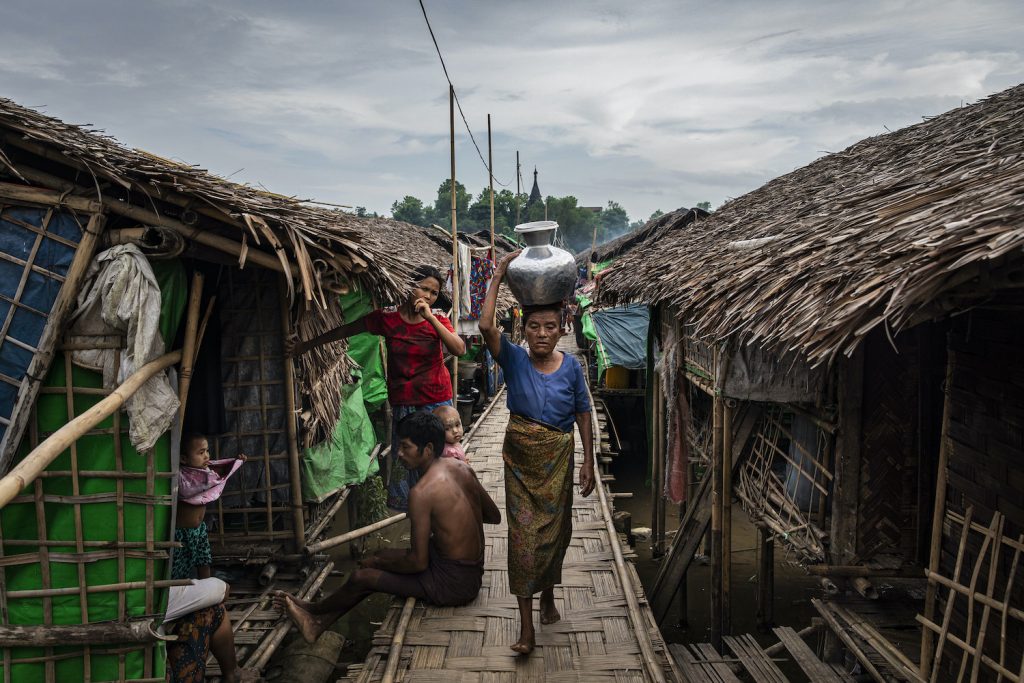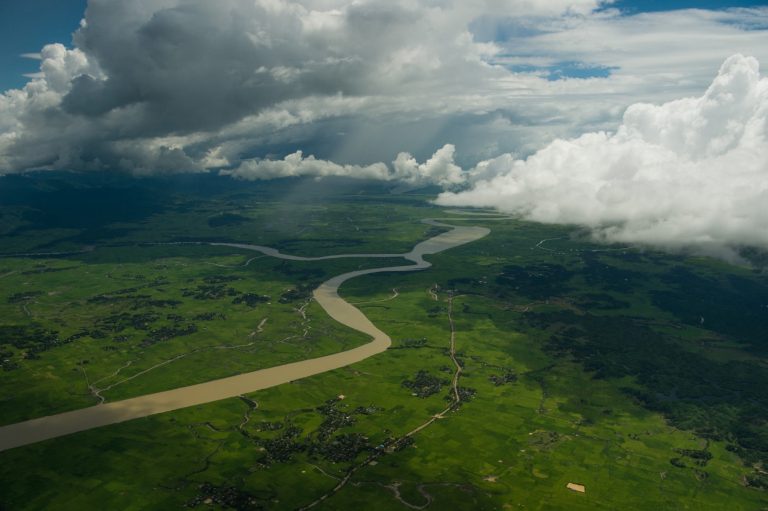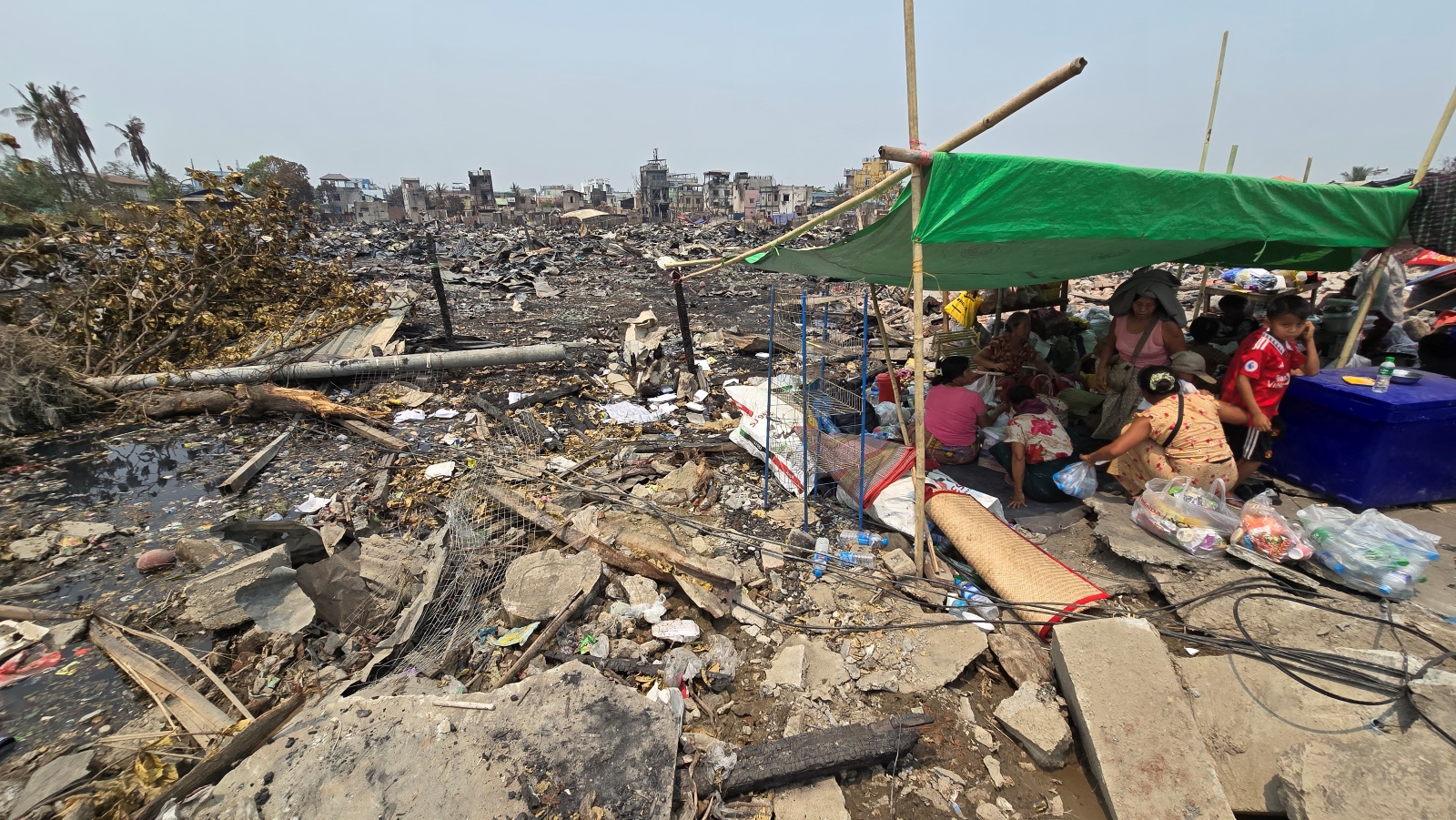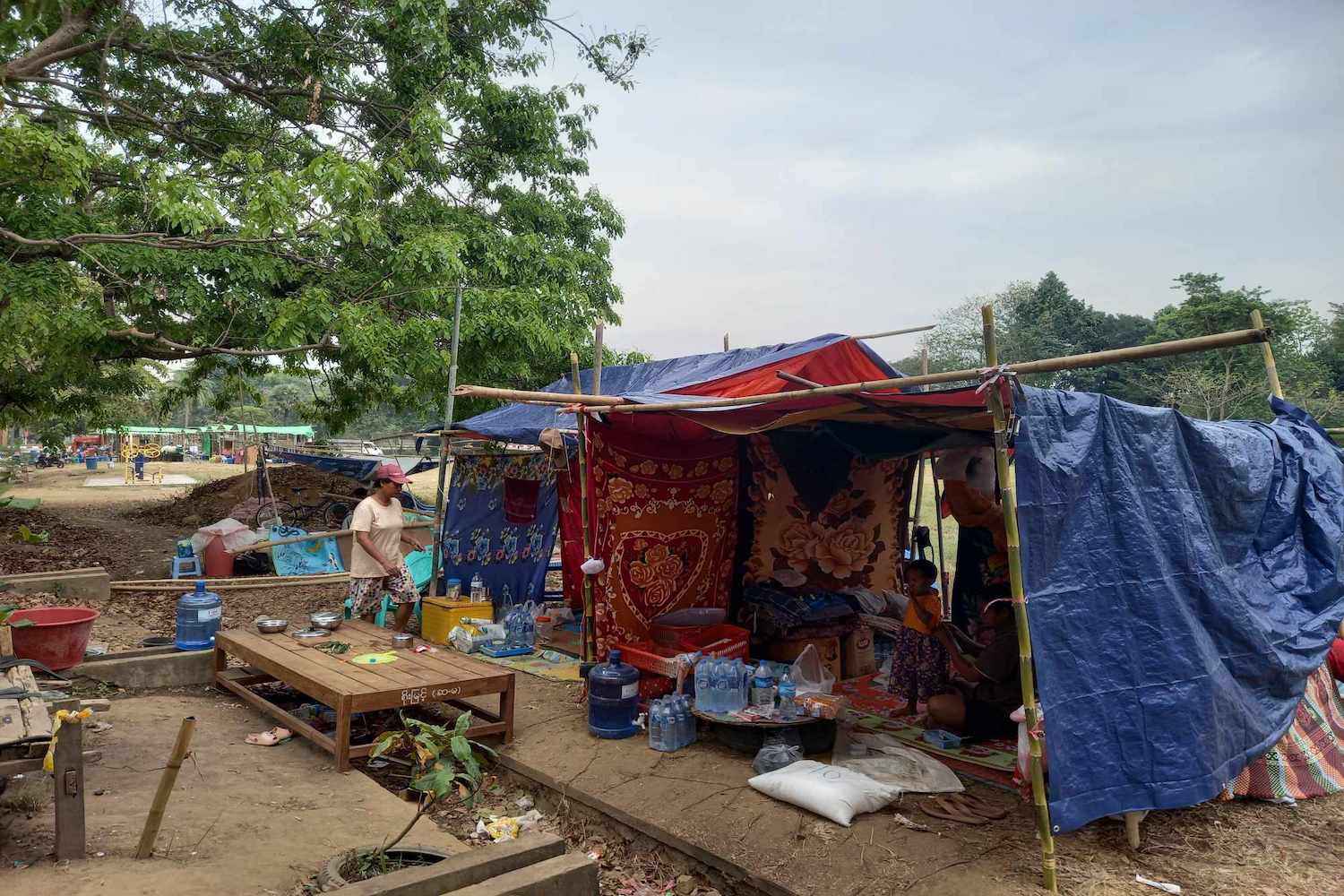Despite the relative lack of armed conflict in Rakhine State in recent months, tens of thousands of internally displaced people still languish in camps where food shortages are becoming more common.
By FRONTIER
In the days following Myanmar’s Thingyan new year celebrations, the pages of state media were filled with festivities in Rakhine State, which gave many the impression that all is normal on Myanmar’s western front. Revelers supposedly flocked to Ngapali Beach while junta officials presided over celebrations in Sittwe, even as other parts of the country boycotted in protest of the coup.
“The images of people in Rakhine State having fun during Thingyan made people outside the state think everyone there was peaceful,” said U Tun Tun Oo, township coordinator for aid organisation Relief International in Mrauk-U Township. “But many were unable to join the celebrations.”
While peace has largely prevailed in Rakhine State since the unofficial ceasefire between the military and the Arakan Army in November 2020, this has brought little comfort for the hundreds of thousands of civilians languishing in camps for the internally displaced.
According to aid group Rakhine Ethnic Congress, nearly 150,000 residents of Rakhine and parts of neighbouring Chin State were displaced by the fighting that largely took place from December 2018 to November 2020. Nearly 50,000 are still living in makeshift camps or sheltering in monastery compounds and are anxious to return home. This wave of internally displaced people joined the thousands of Rohingya and Kaman Muslims who have been confined to camps since a flare-up of sectarian violence in Rakhine in 2012.
IDPs say that life in the camps has only gotten more difficult since the 2021 coup.
“In previous years, we have been able to live with support from the government and international organisations. But the aid is getting low and we get only 17,000 kyats a month for living expenses. We cannot afford to buy enough food,” said U Tun Thein, a former Tinma village resident who now lives in an IDP camp in Kyauktaw Township.
Former residents of Tinma village told Frontier that 132 of its 600 houses were razed by fire and another 400 were destroyed by artillery fire during fighting in March 2020. Several residents were injured, and more than 3,000 Tinma residents sought refuge in nearby IDP camps.
Since the informal ceasefire in November 2020, former residents of Tinma village have made appeals to local authorities for permission to return home, but they say they have received no response. Some tried to return without permission but had to turn back in fear of junta soldiers stationed near their village. Conditions in the camps are also deteriorating, and people feel like they have nowhere to turn.
“We are upset about living in such poor conditions and want to return home as soon as possible,” said Tun Thein.
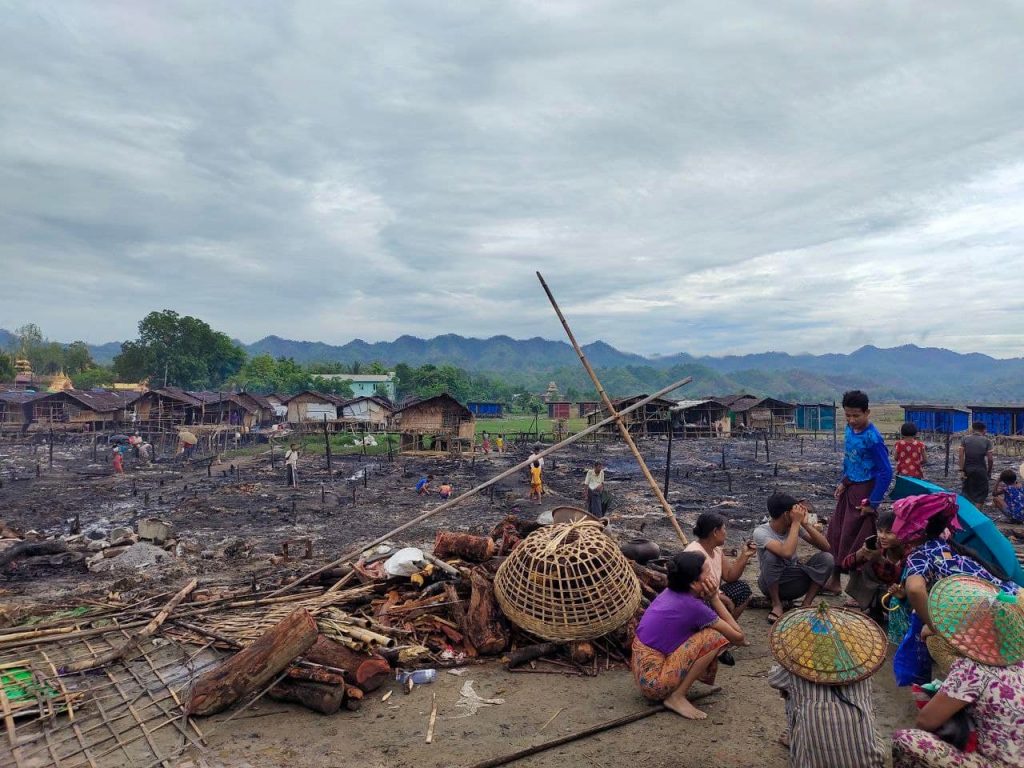
‘We need immediate assistance’
Most IDP camps in Rakhine rely on international aid organisations and donations from civil society groups to supply people’s basic needs, but since the coup, camp residents say they have been suffering from food shortages due to tightening restrictions imposed on these organisations.
“The food rations we receive have declined since the coup. For the past few months, we have not received support from any organisation. Many are starving because of the food shortage,” said a resident of the Thae Chaung IDP camp for Muslims in Sittwe.
Rakhine IDPs at camps in Kyauktaw, Mrauk-U, Buthidaung, Myebon and Ponnangyun townships said in March that they had not received their regular monthly support from either the military regime or international organisations for two months in a row, and have not been told why they have been cut off or when they may receive support again.
A mother of five at the Myo U Gaung IDP camp at Mrauk-U in central Rakhine who asked not to be named said she had to borrow rice to feed her family. “I have only enough rice for a week. If it runs out, I don’t know what I will do to feed my children,” she told Frontier.
Adding to her difficulties, the shelter in which she lives was one of more than 150 destroyed by strong winds on April 20. There are a total of 259 shelters at the Myo U Gaung camp. “We need immediate assistance and materials to repair the shelters,” she said.
U Hla Thein, the spokesperson for the Rakhine State Administration Council, the military regime’s political apparatus, dismissed claims about disruptions to the delivery of aid to the camps.
“Sometimes, there may be delays in providing aid to the camps, but regular monthly support is still being provided. The government has no plan to stop providing aid, but I notice that media reports often blame us and say we are not providing aid to the IDPs,” he told Frontier on April 22.
Residents of IDP camps supported by the junta’s Ministry of Social Welfare, Relief and Resettlement are meant to receive approximately 800 grams of rice per person per day, supplemented by a cash distribution of K18,000 per person per month provided by aid organisations such as the United Nations World Food Programme and the International Committee of the Red Cross. However, this support only reaches IDPs recognised by the Rakhine SAC, said civil society groups, and most IDPs we spoke with who were receiving cash distributions received lesser amounts.
Although aid group Rakhine Ethnic Congress estimates that over 150,000 people were displaced by the last few years of conflict, the Rakhine SAC puts that number closer to 70,000. Neither of these numbers included the Rohingya and Kaman people displaced prior to 2018. The World Food Programme told Frontier via email that it has been providing aid for 200,000 people in Rakhine State.
The WFP said that there has been “no suspension of support from WFP in the recent weeks and months” and the programme “has not received any reports of food shortages in IDP camps and villages covered by WFP operations.”
“International organisations have to work based on [Rakhine SAC’s] data. If there are IDPs in places not shown by the data, aid organisations have to seek permission to provide assistance to them. Even if a permit is issued, transport to such locations is sometimes banned for ‘security reasons’,” said U Zaw Zaw Tun, the Rakhine Ethnic Congress secretary.
Rakhine aid groups say soldiers at checkpoints also often search trucks transporting supplies provided by international organisations and sometimes confiscate the rice and cooking oil. They said it was common in the past for the military to arrest members of civil society groups and accuse them of helping or associating with the AA. The arrests had the effect of discouraging residents of the state from making or delivering donations aimed at helping IDPs.
“Even our team, which collects on-the-ground data for aid groups, works under this pressure,” said Zaw Zaw Tun.
When food supplies ran low in the past, some residents could leave the camps and find jobs so they could support their families. Ma Myo Sandar, a resident of the Myatsaung IDP camp in Sittwe, said restrictions imposed since the coup had made it harder to leave the camps to find work.
“Once they [the military] took power, we had to undergo inspections at many checkpoints when we left the camp for work. We don’t want to be inspected. We can no longer cut bamboo in forests or fish in creeks because soldiers in military vehicles and boats are going around conducting checks,” Myo Sandar said.
For others, movement restrictions have been even harsher and long lasting. U Thar Hla Shwe, a leader at the Thet Kel Pyin camp for Rohingya in Sittwe, said its residents had endured constant hardship during the past 10 years. “We are not even allowed to go to Sittwe town,” he said.
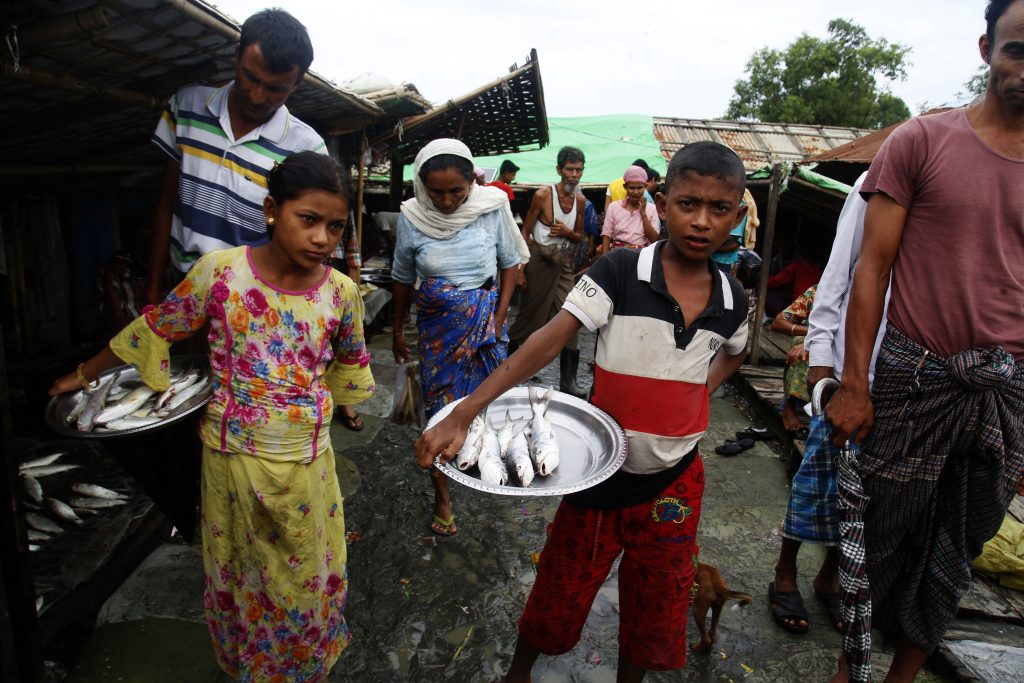
‘No one wants to go home without their safety guaranteed’
Rakhine civil society groups say only two-thirds of the 150,000 people displaced by the recent conflict have been able to return home. While the remaining 50,000 are still living in the camps, some who say they could no longer tolerate the conditions have abandoned what little they have been able to build in the camps in search of employment.
“No one wants to go home without their safety guaranteed. But some have decided to return home and others have moved elsewhere because of food shortages and the bad conditions in the camps,” said Tun Tun Oo from Relief International. “The junta is not telling them to leave, but they are not receiving enough aid and their temporary shelters are being torn down.”
“How can they live in the camps during the monsoon season in these circumstances? The situation is forcing IDPs to leave camps,” he added.
Camp leaders say that on March 8 the Rakhine SAC announced that people displaced by the conflict between the Tatmadaw and the AA would be permitted to apply for Rakhine SAC approval to return to their homes.
“When the military gives permission, we arrange for the IDPs to return home, and provide [each household] with K500,000 in cash, a month’s supply of rice and cooking, and the transportation,” said Rakhine SAC spokesperson Hla Thein.
IDPs in Ann Township who were recently able to return to their villages said that while some households received the promised assistance, not everyone did.
In addition to uncertainty about forthcoming aid, camp residents say the danger of landmines, the fragility of the ceasefire and houses being destroyed during the conflict have prevented IDPs from Tinma village in Kyauktaw Township and Aung Thar Si, Kyauktan and Htee Swal villages in Rathedaung Township from returning home.
Meanwhile, there has been little effort by the authorities to resettle the 133,000 Rohingya and Kaman, who are forbidden from leaving the 14 camps they have been confined to since 2012, unlike their ethnic Rakhine counterparts.
There are about 50,000 people living in six camps for Rohingya and Kaman Muslims in Buthidaung Township who are struggling to survive. “We have had to sell our possessions to buy rice. Some people steal the property and food of their neighbours. It is distressing to have such a dreadful situation,” said Mohamad Abdul Alan, who lives in the Taungwa IDP camp in Buthidaung Township.
A resident of Thae Chaung IDP camp in Sittwe said the loss of freedom and enforced joblessness were the main reasons for fleeing the camps and risking perilous journeys by land or sea to escape Myanmar.
“They know it is very risky and have to face many difficulties to reach those countries. But we do not want to live under this terrible oppression. People would rather take the risk than die in the camps,” said a Muslim man, who asked only to be identified as such.
Hla Thein said he had nothing to say about those he referred to as “Muslim IDPs”, other than that international organisations had mainly taken responsibility for providing them with support.
However, Hla Thein did say that some IDPs are not returning home because they would rather live off the support they received from donors and prefer the opportunities to earn money in the urban areas near their camps.
“Some people are still living in camps and that’s why we cannot close any IDP camp in Rakhine State even though the fighting is not as severe as before,” he said.
For many though, there are no homes to go back to. According to REC secretary Zaw Zaw, around 1,000 houses in about 40 villages were destroyed during the two years of fighting between the military and the AA, and only about 300 of the houses have been rebuilt since the informal ceasefire.
“We assume that the junta is unwilling to make rebuilding a priority,” said Zaw Zaw. He added that it is also possible that the delay is due to the lack of prioritisation the AA has given to the issue of resettlement.
Last December, Ma Nu Nu Aye, 33, left the Yan Aung Myay IDP camp in Buthidaung town for the first time in more than two years. She returned to the remains of her humble wooden home in Buthidaung Township’s Sayditaung village, which she fled during fighting between the Tatmadaw and AA that displaced 1,200 villagers in March 2019.
“My house was badly damaged and I have no money to repair it,” Nu Nu Aye said, “The rice I received at the camp is almost exhausted. The farmland is ruined and mines have not been cleared from the area. I still don’t know what to do in the village.”


